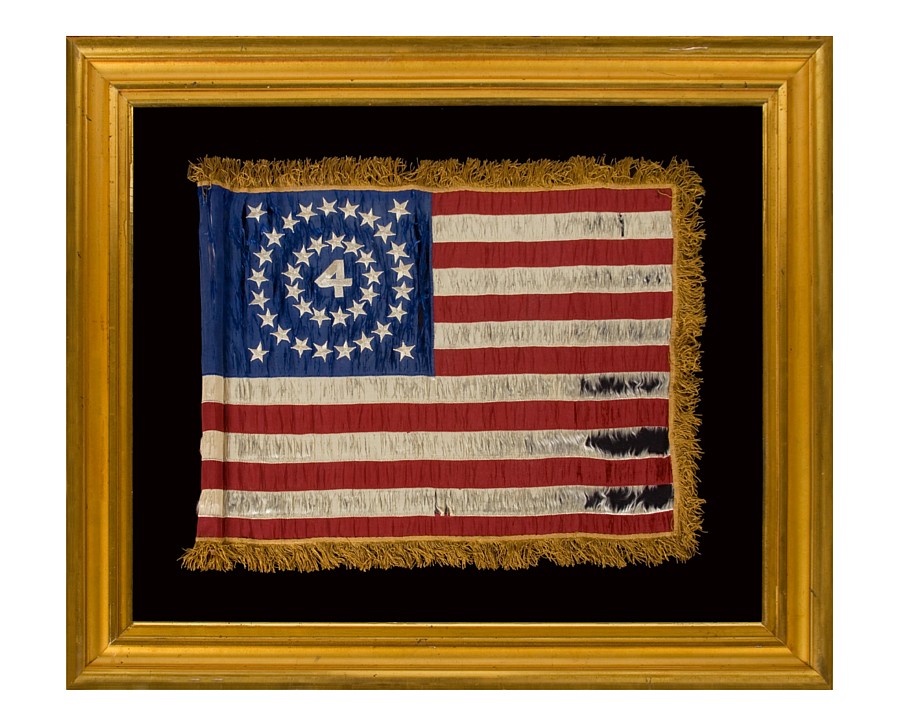
| |
RARE AND BEAUTIFUL 38 STAR FLAG, AN INDIAN WARS PERIOD FLANK GUIDON OF THE 4th U.S. INFANTRY, WITH A MEDALLION CONFIGURATION SURROUNDING THE NUMERAL "4". 1876-1889, COLORADO STATEHOOD |
|
| Available: |
Sold |
| Frame Size (H x L): |
26.25" x 29.5" |
| Flag Size (H x L): |
17" x 19.5" |
|
| Description....: |
|
RARE AND BEAUTIFUL 38 STAR FLAG, AN INDIAN WARS PERIOD FLANK GUIDON OF THE 4th U.S. INFANTRY, WITH A MEDALLION CONFIGURATION SURROUNDING THE NUMERAL "4". 1876-1889, COLORADO STATEHOOD:
Indian Wars period flank guidon of the 4th U.S. Infantry, with 38 stars, made during the Indian Wars period. Infantry guidons were attached to a wooden pole that fit down the barrel of a musket. A soldier would shoulder his rifle, thereby displaying the flag and marking the end of the flank. This helped in the formation of troops and was a visual aid for officers.
Colorado became the 38th state in 1876 and on July 4th of 1877, the 38th star was officially added to the American National flag to reflect that state's addition. The 38 star flag fell out of use on July 4th of 1890, following the addition of five more states.
Interestingly enough, the 4th U.S. Infantry happens to have been particularly active in Colorado. One of its most notable actions involved a conflict with the Ute Indians. In September of 1879, Indian Agent N. C. Meeker, at White River Agency (Colorado), became involved in a dispute with Northern Utes and requested assistance from the Army. In response, Major T. T. Thornburgh's column of some 200 men (including parts of the 5th Cavalry and 4th Infantry) set out from Fort Steele, Wyoming. On September 29th, this force was attacked and besieged in the Red Canyon by 300 to 400 warriors. Thornburgh was killed, and his command was finally relieved by elements of the 9th Cavalry (a buffalo soldier unit), which arrived on October 2nd, and the 5th Cavalry, under Col. Wesley Merritt, which arrived on the 5th of October. In the meantime, Meeker was captured, tortured, and executed, while most of his staff were massacred. Before the Utes were pacified, in November of 1880, several thousand troops had taken the field. In 1906, the Utes of this area left their reservation and roamed through Wyoming, terrorizing the countryside, until they were forced back by elements of the 6th and 10th Cavalries.
The flag is expertly hand-sewn, constructed of red, white, and blue silk. The numeral "4" lies in the center of a beautiful, double wreath configuration of stars, with a flanking star in each corner. These are embroidered with white silk thread. The stripes and canton are rolled over to form the sleeve, which bears a cotton liner inside for stability. A decorative silk fringe circumvents the hem along the top, bottom and fly end.
I previously owned another flag that was made for this same unit, and in the same size and style. It was viewed by museum curator and American flag expert Howard Madaus, on an occasion when he visited me in Pennsylvania. During the course of our conversations, Madaus stated that he had recently uncovered a military order that contracted for the manufacture of flags of this type in 1888. Our conversation soon drifted to other flags and it is most unfortunate that I never had the opportunity to re-revisit the subject with him before his untimely death. I would like to have inquired about exactly where and when both these and any others were made.
19th century Stars & Stripes that were military production flags and were carried by land forces are rare in the private marketplace. Of even greater interest are those military flags with a strikingly graphic presentation, with ties to a historic unit, and in a size small enough to easily frame and display. Infantry flank guidons are the basically the smallest type of flag with sewn construction that was made with any regularity during this early period in American history; so for all of the above reasons, they are an extraordinary find, are sought after by collectors, and are a great addition to any flag collection.
Mounting: The outstanding, lemon gold frame dates to the period between 1830 and 1860. This is a sandwich mount between 100% cotton and U.V. protective acrylic.
Condition: Silk flags were practical for land-use by military forces, due to their light weight, but seldom do they survive intact. In this case, the striations and fabric loss represent both field use and the weighted silk fabric that was used in its construction. Silk of this period almost always experiences breakdown due to addition of weighting agents that were caustic to the fabric over time. These increased the amount of money that a merchant could obtain for the fabric, which, in the period between 1820 and 1850, began to be sold by the pound instead of by length. Due to this fact and the rigors of military use during the 19th century, the present state of the flag can be reasonably expected. It is also an especially beautiful flag, in-part because of the damage, which clearly exhibits its age and the circumstances through which it survived to the present day. |
|
|
|
| Collector Level: |
Flags for the truest Patriots. My best offerings |
|
| Flag Type: |
Sewn flag |
|
| Star Count: |
38 |
|
| Earliest Date of Origin: |
1876 |
|
| Latest Date of Origin: |
1889 |
|
| State/Affiliation: |
Colorado |
|
| War Association: |
1866-1890 Indian Wars |
|
| Price: |
SOLD |
|
| |
Views: 5720 |
|
|
|

